Newsletters
- Home
- Publications
- Newsletter Archive
- Newsletter
January/February 2014
Inside This Issue:
- Center Board of Directors Announces 2014 Research Grant Projects
- Chairman's Message
- Research Examines Telehealth Implementation in Rural Pennsylvania
- Rural Snapshot: Educational, Career and Residential Goals of Pennsylvania Rural Youth
- Did You Know: Nuclear Families in Rural Pennsylvania
- Fast Fact: Percent of Rural Pennsylvanians Under 18 and 65 Years Old and Older, 1950 to 2010
- Just the Facts: Per Capita Income
Center Board of Directors Announces 2014 Research Grant Projects
The Center for Rural Pennsylvania’s Board of Directors approved eight research grant proposals as part of the Center’s 2014 Research Grant Program at its December meeting.
Faculty members of Pennsylvania State University, the State System of Higher Education universities, and a University of Pittsburgh regional campus submitted the successful proposals and will begin their respective research in February.
“This research will continue building on the Center’s past research results and rich database to provide policy and decision makers with information that is unique to rural Pennsylvania and its nearly 3.5 million rural residents,” Senator Gene Yaw, Center board chairman, said.
The approved research grant projects are summarized below.
Pennsylvania Rural Volunteer Fire Companies’ Financial Fitness
Dr. Melanie O. Anderson of Slippery Rock University of Pennsylvania will survey Pennsylvania volunteer fire companies to gather information on their financial status. It will detail how financial issues affect rural volunteer fire companies’ goals to meet community needs.
The Economic Impact of Pennsylvania Designated Heritage Areas
Dr. John M. McGrath of the University of Pittsburgh €“ Johnstown will estimate the economic impact of Pennsylvania’s Designated Heritage Areas. The research will use both qualitative and quantitative methods and focus on several heritage regions that encompass different geographic regions of the state.
The Marcellus Shale Impacts Studies Wave 2: Chronicling Social and Economic Change in North Central Pennsylvania and Southwest Pennsylvania
Dr. Kathryn Brasier of Pennsylvania State University will lead an interdisciplinary team of researchers in two studies that will assess the effects of Marcellus Shale activity in north central Pennsylvania and in southwest Pennsylvania, respectively. The studies will examine multiple community sectors in the regions including housing, economies, crime, agriculture, health and traffic.
Assessing the Potential for Health Workforce Supply Shortages in Rural Pennsylvania
Dr. Brandon Vick of Indiana University of Pennsylvania will use results from the Pennsylvania Health Workforce Surveys to provide a comprehensive description of Pennsylvania’s current health workforce. The research will focus on rural/urban differences for various specialty areas, and potential sectors and job types experiencing or likely to experience workforce supply shortages.
Analysis of Special Education Funding in Rural and Urban School Districts
Dr. William Hartman of Pennsylvania State University will analyze secondary data on the number of special education students and school district special education expenditures over the past 10 years for rural and urban school districts.
Analysis of Unearned Income in Pennsylvania
Todd Behr of East Stroudsburg University of Pennsylvania will analyze various components of personal income in Pennsylvania counties, identify changes and trends in both earned and unearned income, and compare the various components of unearned income with county socio-economic and demographic variables as well as key economic indicators.
Evaluating Campaign Success: Ten Years of the United Way in Pennsylvania
Dr. Chad M. Kimmel of Shippensburg University of Pennsylvania will evaluate the success of the annual community fundraising campaigns of all United Ways in Pennsylvania from 2003 to 2013. The research will explore the extent to which community socio-economic and demographic characteristics impact United Way campaign success.
2015 research program
As this year’s grantees begin their projects, the board is identifying topics for the 2015 Research Grant Program. The grant topics will address relevant issues impacting Pennsylvania’s rural residents.
After the topics have been identified, the Center will issue its Request for Proposals (RFP).
While the Center’s grant program is only available to faculty at the Pennsylvania State System of Higher Education universities, Pennsylvania State University, and the regional campuses of the University of Pittsburgh, the Center encourages cooperation and collaboration between these faculty and other public or private organizations.
For a copy of the 2015 RFP or more information about the Research Grant Program, call the Center at (717) 787-9555 or visit www.rural.palegislature.us.
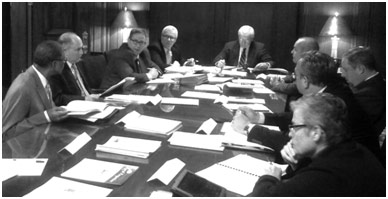
Center board members and staff review submitted research grant proposals at the December 2013 board meeting.
Pictured left to right: Dr. Livingston Alexander, Rep. Rick Mirabito, Jonathan Johnson, Barry Denk, Sen. Gene Yaw,
Rep. Garth Everett, Steve Brame, Taylor Doebler and Dr. Karen Whitney.
Chairman's Message
Happy New Year. I hope that many of you had the chance to visit the 98th Annual Pennsylvania Farm Show this January. This traditional welcome to the New Year is the nation’s largest indoor agricultural exposition. It features some of Pennsylvania’s finest farm animals and food, as well as competitive and commercial exhibits. Every time I attend, I learn something new about our agricultural industry. I’ve even enjoyed competing in the Celebrity Milking Contest.
The Farm Show truly offers something for everyone €“ up close and personal. Whether you’re standing next to prize winning livestock, cheering at the famous rodeos, tasting Pennsylvania’s finest at the Food Court, or checking out the latest farm equipment, the Farm Show is a perfect forum for connecting with our farms and our farm families, who work tirelessly generating our food and fiber.
I am very impressed by the enthusiasm of our young farmers who participate in the various activities of the Farm Show. It is so important to engage our youth in activities that matter to them and to provide our youth with information and experiences on future career opportunities, particularly those that will keep them in our rural communities. The Center for Rural Pennsylvania recognizes the importance of keeping our young folks here.
On Page 4, we highlight the results of a longitudinal study of rural youth that was sponsored by the Center. The study gathered a great deal of information about the educational, career and residential goals of two groups of rural youth over a roughly 6-year period. According to that research, about 32 percent of students who were in 7th grade when the study began wanted to live in rural Pennsylvania as an adult. By the end of the study, 46 percent wanted to live in rural Pennsylvania as an adult. Those percentages are encouraging, and they show that a good number of our younger residents like where they live and see the benefits of living in our rural communities.
However, there was also a large percentage of students who were unsure of where they wanted to live or who wanted to move out of Pennsylvania. This suggests that more work needs to be done to show our youth the opportunities available to them in rural Pennsylvania and the value they add to their communities. Over the course of the next several months, we’ll continue providing data from the survey to provide other insights about the things that are important to our rural youth and some ideas on how we can encourage them to stay in or return to Pennsylvania’s rural communities.
Senator Gene Yaw
Research Examines Telehealth Implementation in Rural Pennsylvania
The Center has released the research report, Telehealth in Rural Pennsylvania. The research was conducted by Dr. C.J. Rhoads, Gary Bankston, Justin Roach, Roger Jahnke and William Roth of Kutztown University of Pennsylvania in 2012 and 2013. It set out to describe how and to what extent telehealth is being implemented in rural Pennsylvania and to identify obstacles preventing its wider implementation.
Telehealth is the use of electronic information and telecommunications technologies to support long-distance clinical health care, patient and professional health-related education, and public health and health administration. It has been proposed as a possible solution to meeting the challenges of improving the quality of healthcare while lowering costs and increasing access in rural Pennsylvania.
The report, Telehealth in Rural Pennsylvania, is available on the Center’s website at www.rural.palegislature.us.
Rural Snapshot: Educational, Career and Residential Goals of Pennsylvania Rural Youth
The Center for Rural Pennsylvania contracted with Pennsylvania State University researchers in 2004 to begin a longitudinal study of rural Pennsylvania school students to understand their educational, career and residential goals and the factors influencing these goals. The study was motivated by the outmigration of youth and young adults from rural Pennsylvania.
Dr. Diane K. McLaughlin, Dr. Carla Shoff, Jennifer Krum, Mary Ann Demi, and Jannety Mosley of Penn State University and Dr. Anastasia R. Snyder of Ohio State University conducted the Rural Youth Education Study by following two groups of youth from 11 rural Pennsylvania school districts. The study collected data every other year for four waves beginning in 2005.
At the beginning of the study, the younger group was in 7th grade and the older group was in 11th grade. By the final wave, the younger group was 1 year out of high school and the older group was 5 years out of high school.
The Center will share the data from this study in this and upcoming installments of Rural Snapshot, specifically focusing on the younger group.
The table below provides the response rates for the younger group during each wave of the study.
Results from the first three waves of the study are available on the Center’s website at www.rural.palegislature.us/publications_reports.html, under the subheading “Education.”
Researchers who want access to the data for further analysis should call or email Jonathan Johnson at (717) 787-9555 or johnsonj@rural.palegislature.us.
Younger Cohort Response Rates, Waves 1 through 4
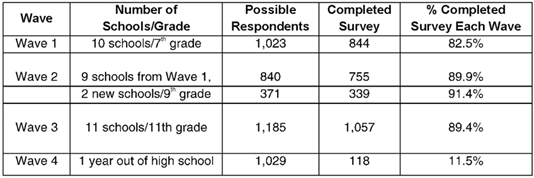
Rural Students Who Wanted to Earn a High School Diploma or Less, Waves 1 Through 4
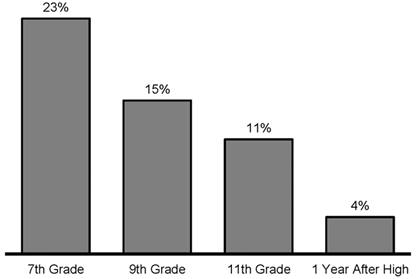
Rural Students Who Wanted to Earn a 4-Year Degree, Waves 1 Through 4
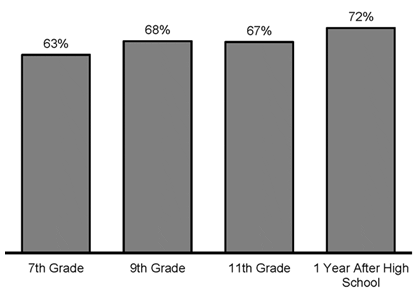
Occupational Goals of Rural Students, Waves 1 and 4
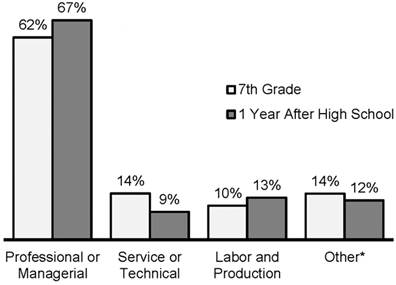
Where Rural Students Want to Live as Adults, Waves 1 and 4
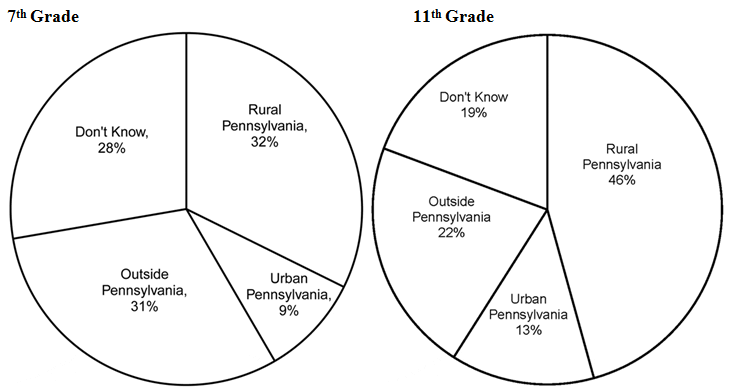
Did You Know: Nuclear Families in Rural Pennsylvania
A “nuclear family” is a married couple with children under 18 years old.
31 percent Decline in the number of rural nuclear families from1980 to 2010.*
19 percent Rural households that are nuclear families. In 1980, nuclear families made up 34 percent of all rural households.*
42 percent Families with two children. 38 percent have one child; 15 percent have three children; and 5 percent have four or more children.**
64 percent Families in which both parents are working. For 27 percent of families, the father is working and the mother is not; 5 percent, the mother is working and the father is not; and 4 percent, neither parent is working.**
83 percent Families that are homeowners. 17 percent are renters. Among homeowners with a mortgage, their monthly housing costs in 2011 were $1,340, or 19 percent of their income. Among renters, their median monthly gross rent was $845, or 22 percent of their income.**
$75,766 Median household income for rural nuclear families. Among all rural households, median income was $46,995.**
6 percent Rural nuclear families in poverty.**
40 percent Rural nuclear family couples that have been married between 10 and 19 years. 16 percent have been married for less than 5 years; 22 percent have been married for 5 to 9 years; and 22 percent have married for more than 20 years.**
Fast Fact: Percent of Rural Pennsylvanians Under 18 and 65 Years Old and Older, 1950 to 2010
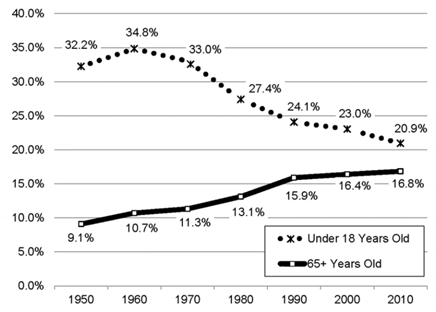
Data source: U.S. Census Bureau
Just the Facts: Per Capita Income
The latest data from the U.S. Bureau of Economic Analysis indicate that rural incomes are slowly rebounding from the “Great Recession,” which began in 2008.
From 2011 to 2012, total per capita personal income in rural Pennsylvania increased from $36,725 to $37,256, an increase of $531, or 1 percent (after adjusting for inflation). This was the fourth consecutive year of a slow but steady increase.
Urban incomes also increased during this period, but at a much slower rate. From 2011 to 2012, total per capita personal income went from $47,705 to $47,991, an increase of $287 or 0.6 percent.
Although urban incomes are $10,735 higher than rural incomes, the income gap has been narrowing. From 2007 to 2012, the gap between rural and urban per capita incomes declined 11 percent.
The increase in rural incomes was helped along by wage growth. From 2011 to 2012, per capita rural wages increased $302 while unearned income increased $229. Unearned income includes interests, dividends, and rent along with personal transfer payments, such as Social Security, unemployment compensation, and pensions.
During the same period, per capita urban wages increased $135 and unearned income increased $152.
Nationwide, per capita personal income increased 1 percent from $43,173 in 2011 to $43,735 in 2012.
North Dakota had the nation’s largest increase at 14 percent, followed by Montana and Indiana, each with 3 percent.
South Dakota was the only state with a decline in per capita income during this period.
Among all states, Pennsylvania had the 35th highest increase in per capita income at 1 percent.
